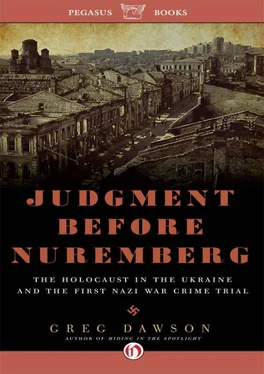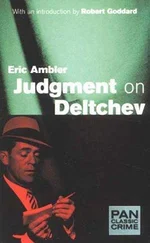This was the image of Germans that my grandfather acquired as a young man and clung to until it was too late. Dmitri Arshansky had befriended Yiddish-speaking German soldiers during their relatively benign occupation of his hometown, Poltava, in World War I. To Dmitri, an amateur violinist who imported a German-made Bechstein piano for his budding prodigies, Zhanna and Frina, Germany represented the pinnacle of musical culture.
Waldemar Klingelhofer matched the image in Dmitri’s mind of German refinement, and also embodied its cursed duality. After graduating from the Wilhelm Classical Gymnasium, young Waldemar worked in a bank to pay for voice lessons and ultimately achieved his dream of touring Germany as a professional opera singer. In another life, Klingelhofer, the artist, and Dmitri, the patron, might have come together one day in a concert hall—Dmitri with his daughters in tow, eager for them to experience firsthand the epitome of musical achievement. In this life, they were destined to come together only as ciphers on opposite sides of a war that would consume them both.
Klingelhofer’s opera career was cut short by an injury to his voice. His best career option in 1935—at the suggestion of a friend—was to join the SD ( Sicherheitsdienst , or Security Service). Two years later he was promoted from clerk to head of the Department of Culture in the SD, which suited his musical training and language skills (he was fluent in Russian). There was no indication that Klingelhofer yearned for a more adventurous mission than administering culture from a desk. But in May 1941, he was among the SD members summoned for duty in the Einsatzgruppen , and that’s when the music died for Waldemar Klingelhofer. The same voice that caressed Mozart and Puccini and Wagner would soon be barking orders to shoot Jews.
The Einsatzgruppen training, such as it was, took place in Pretzsch, a town about fifty miles southwest of Berlin. The several thousand recruits came from various elements of the Nazi security edifice: Gestapo, SD, SS, Waffen SS, Order Police, and local police. They were organized into four Einsatzgruppen —A, B, C, D—ranging from 500 to 1,000 men. These were subdivided into smaller units known as Sonderkommandos, Einsatzkommandos, and Teilkommandos. The top echelon of Einsatzgruppen commanders was top-heavy with lawyers, economists, academics (nearly a third held doctorates), and even the odd theologian, musician, and architect. Heinz Schubert, an officer in this “elite” corps, though not a musician, was a direct descendant of the composer Franz Schubert.
The four Einsatzgruppen formed for Operation Barbarossa were larger versions of Einsatzgruppen that accompanied the Wehrmacht when Germany invaded Poland in 1939. Working with Order Police, Waffen SS, and other forces, the Einsatzgruppen participated in the murder of Polish citizens, including many Christians. A harbinger of the Einsatzgruppe mission and method in the Soviet Union is glimpsed in this eyewitness account of executions in one Polish town: “The first victims of the campaign were a number of Boy Scouts, from twelve to sixteen years of age, who were set up in the marketplace against a wall and shot. No reason was given. A devoted priest who rushed to administer the Last Sacrament was shot too.”
The career officers of the Wehrmacht, the German National Army, were not pleased with aspects of the Einsatzgruppe performance in Poland—drunken killing sprees and gratuitous brutality violated their old-school code—and they protested to Himmler and Heydrich. Not a problem! To minimize friction and preempt jurisdictional disputes in Operation Barbarossa, Hitler drafted a provision giving the Einsatzgruppen —his surrogate id—a blank check for mayhem in the Soviet Union, not answerable to the Wehrmacht, the rapidly atrophying superego separating Nazi war-making from pure criminality.
“The Reichsführer-SS (Himmler) assumes on behalf of the Führer special tasks which arise from the necessity finally to settle the conflict between two opposing political systems,” stated Hitler’s addendum to Directive 21 (Barbarossa). “Within the framework of these duties the Reichsführer-SS acts independently and on his own responsibility.” Translation: the SS was now free to move about the country without their Wehrmacht chaperones, murdering at will, with special attention to communists and Bolshevists—both code words for Jews.
Another key provision of the agreement allowed the killing squads to operate not only in rear areas, as it followed the army, but also on the front lines. “This concession was of great importance, for the Jews were to be caught as quickly as possible,” wrote Hilberg. “They were to be given no warning and no chance to escape.” In this manner, “several hundred thousand Jews could be killed like sleeping flies” in the early stages of the operation. [4] Hilberg, The Destruction of the European Jews , 187, 192.
Once German soldiers and tanks crossed the Soviet border on June 22, 1941, and began to roar east unopposed, all pretense of civilized restraint vanished in an intoxicating cloud of Teutonic id that obliterated the fine line between military and ideological warfare. The military goals of the Wehrmacht and the genocidal goal of the Einsatzgruppen merged into one vast criminal enterprise, each justifying the other.
The legal brilliance, and dramatic power, of American prosecutor Ben Ferencz’s case against 24 Einsatzgruppen commanders at Nuremberg is that it was based entirely on the defendants’ own words—thousands of field reports written by Einsatz commanders and sent to Berlin. In the end, Teutonic barbarism was undone by German efficiency.
“Two large-scale actions were carried out by the platoon in Krupka and Sholopaniche, 912 Jews being liquidated in the former and 822 in the latter,” read one typical report. “ Einsatzkommando 5 took care of 506 Bolsheviks and Jews in the course of 14 days,” echoed another. Jews were considered “useless eaters,” reflected in this field report from central Ukraine. “It was impossible to supply food to the Jews as well as the children and subsequently there was an ever-increasing danger of epidemics. To put an end to these conditions, 1,107 Jewish adults were shot by Kommando 4a, and 561 by the Ukrainian militia.”
The careful litany of slaughter goes on page after page. The magnitude of the homicide is even more difficult to grasp than its depravity.
“One million corpses is a concept too bizarre and too fantastical for normal mental comprehension,” Ferencz said at Nuremberg. “To the average brain one million is more a symbol than a quantitative measure. However, if one reads through the reports of the Einsatzgruppen and observes the small numbers getting larger, climbing into ten thousand, tens of thousands, a hundred thousand and beyond, then one can at least believe that this actually happened—the cold-blooded, premeditated killing of one million human beings.”
Our resident opera-star turned SS Major Waldemar Klingelhofer was no Otto Ohlendorf, the suave, handsome prince of the Nazi red tide who blithely admitted at Nuremberg to supervising the murder of 90,000 Jews as commander of Einsatzgruppen D. Though a minor spear carrier to Ohlendorf’s malignant Wotan, Klingelhofer did his part as leader of a Vorkommando to drive up the death count. The trial established that he ordered and supervised the murder of thousands, and in his pre-trial affidavit Klingelhofer admitted shooting 30 Jews, including three women to whom he extended a unique brand of Nazi mercy. “He had them blindfolded for the execution and then ordered that they be given a separate grave,” the prosecution at Nuremberg stated.
Читать дальше












